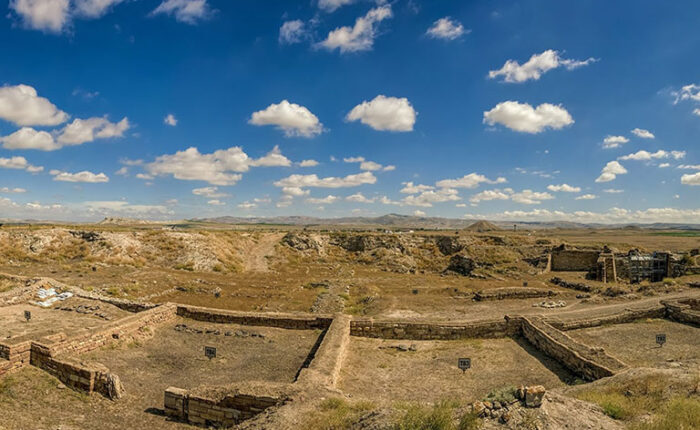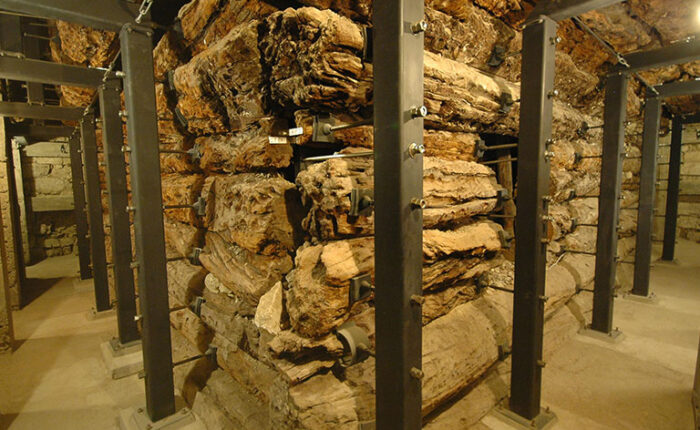From the Phrygians to Alexander the Great, Gordion was at the heart of history. This ancient city, which was one of the capitals of the Phrygian kingdom, dates back at least 4,000 years after the Bronze Age.
The site was excavated by Alfred Korte and Gustav Korte in 1900, who discovered artifacts from the site. Most of their findings are housed in the Istanbul Archaeological Museums, the Gordion Museum in Yassihoyuk, and the Museum of Anatolian Civilizations in Ankara.
The Gordion region sits in an area where the Porsuk and Sakarya rivers converge. A place steeped in history, it is home to the remains of some of the most significant historical empires.
Ankara Esenboga Airport is a large airport serving Ankara and the surrounding area. Scheduled rides or our tour guides will pick you up from the airport and take you to your hotel in 1 hour and 30 minutes.
A daypack is essential for a trip to Gordion. It will give you a place to store essentials, like water and sunscreen, and extra storage space for souvenirs.
With just one day in Gordion, you can see the highlights of this small town and visit the Midas tomb. Although it has fewer sights or attractions than its big-city counterparts, Gordion has much to offer, including a museum focusing on local history.
Gordion, an ancient site in modern-day Turkey, has been an important crossroads since the time of the Phrygians and, as such, has seen a wealth of history unfold around it.
Gordion lies at the center of Ankara Province, which means it gets hot and humid in the summer months, and winters are cold and damp. So if you want to avoid the rain and cold, come in spring or autumn.
The Ankara International Film Festival is one of the world’s leading film events and takes place every year in mid-March.
The city’s most exciting feature is its ancient remains. While it isn’t a touristy hotspot, there are enough historical sights to occupy you.
While exploring the capital city, the highlight for many will be the tasty local cuisine.
Ankara tava is a traditional Turkish dish that originated in Ankara. The dish is often prepared with lamb, orzo noodles, oil, hot peppers, tomatoes, onions, tomato paste, garlic, cumin, salt and black pepper.
Ekmek kadayifi, a staple of traditional Ottoman cuisine and arguably one of the best Turkish dishes, is very popular in Ankara. It’s a bread pudding served with kaymak (clotted cream) and topped with syrup.
The rich and diverse selection of culinary delights in Gordion is something that will make your trip worth it.
While Ankara is the capital and most travelers admire the artifacts displayed at the Museum of Anatolian Civilizations, if you are specifically interested in Phyrgians, it is best to travel to the destination with an expert guide on a private tour.
It can save lots of time and energy rather than trying to get there on your own with public transportation, and you don’t need to worry about the language barrier.
Nevertheless, it’s best to learn Turkish or at least get by with simple phrases like “How are you?” or “Where are you from?” in Turkish. It will help you communicate better with the locals and help you feel more comfortable.



Explore the highlights of the historical town of Gordion and experience its fascinating history and archaeological legacy. Here are some sights to keep in mind:
The Gordion Museum is located in Yassihoyuk village, 93 km from the capital city of Ankara. It showcases ancient treasures from the region, including pottery and jewelry, especially Phrygian artifacts. It also has a Babylonian coinage collection on display.
If you are traveling to the region and looking for a cultural experience that is a bit different, this is a great place to visit. It’s not a regular museum, and it’s worth seeing.
Midas Mound is an archaeological site located at the eastern end of present-day Yassihoyuk village. The first evidence of a royal tomb from the time of the Phrygians was discovered by the American Near Eastern archaeologist Rodney Young.
Along with his team, he unearthed a burial chamber where the remains of a man in his early 60s were buried. Inside the tomb was an extensive array of grave goods, including brazen vessels, pottery, and many drinking and ritual cups.
The tomb’s discovery was especially significant because, unlike many other tombs found in the region, this tomb had never been looted and yielded the largest number of objects found inside a tomb.
The discovery of King Midas’s tomb was a significant archaeological event that proved the Phrygian presence in Ankara Province.
The remains of the ancient city of Gordion (8th century BC) are located on a hill in the present-day Yassihoyuk village, southwest of the capital city of Ankara.
It was one of the great cities of the ancient world, the administrative center of the vast Phrygian empire that stretched from the Aegean Sea to the eastern shores of the Black Sea and from central Anatolia to northern Mesopotamia. The site is widely considered the birthplace of the myth of Gordius and the legendary Gordian knot.
The first excavations were conducted by the German Korte brothers in 1900-1905. Although these excavations produced many vital finds, they lasted only one season. Since then, many more archaeological campaigns have been carried out at the site, most notably by Rodney S. Young between 1950 and 1973.
Today, it is among the few places in the world that have preserved many artifacts from past civilizations. These include statues, pottery, coins, and many other items.
Anitkabir is the resting place of Mustafa Kemal Ataturk, the founder of modern Turkey.
The mausoleum is located within Ankara city and is open to the public. There is also an exhibition about the life of Ataturk inside the building. It was constructed from travertine, concrete, and marble and was designed by the renowned Turkish architects Ahmet Orhan Arda and Emill Onat in 1944. It took nine years to complete.
The mausoleum is a monument of Turkish history, a symbol of unity, and a place where Turks of all ethnic groups gather.
Ankara Castle is a historic site located in the heart of the old city. The castle was built between the 7th and 8th centuries, and most of the original buildings remain. The site has been the location of many historical events in Turkish history.
The Museum of Anatolian Civilizations was founded in 1921. It explores the culture, art, and history of the people of Anatolia, including the earliest inhabitants, the Hittites, the Assyrians, the Phrygians, the Lydians, the Greeks, the Romans, and the Byzantines.